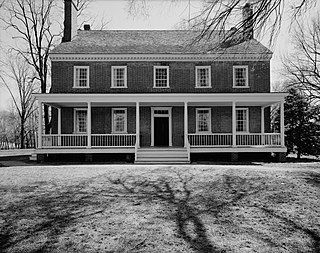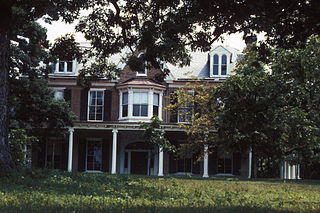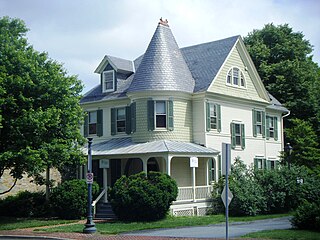
Historic Locust Grove is a 55-acre 18th-century farm site and National Historic Landmark situated in eastern Jefferson County, Kentucky. The site is owned by the Louisville Metro government, and operated as a historic interpretive site by Historic Locust Grove, Inc.

Woodlawn is a historic house located in Fairfax County, Virginia. Originally a part of Mount Vernon, George Washington's historic plantation estate, it was subdivided in the 19th century by abolitionists to demonstrate the viability of a free labor system. The address is now 9000 Richmond Highway, Alexandria, Virginia, but due to expansion of Fort Belvoir and reconstruction of historic Route 1, access is via Woodlawn Road slightly south of Jeff Todd Way/State Route 235. The house is a designated National Historic Landmark, primarily for its association with the Washington family, but also for the role it played in the historic preservation movement. It is now a museum property owned and managed by the National Trust for Historic Preservation.

Sequoyah's Cabin is a log cabin and historic site off Oklahoma State Highway 101 near Akins, Oklahoma. It was the home between 1829 and 1844 of the Cherokee Indian Sequoyah, who in 1821 created a written language for the Cherokee Nation. The cabin and surrounding park, now owned by the Cherokee Nation, was declared a National Historic Landmark in 1965.

Cedar Lawn, also known as Berry Hill and Poplar Hill, is one of several houses built near Charles Town, West Virginia for members of the Washington family. Cedar Lawn was built in 1825 for John Thornton Augustine Washington, George Washington's grand-nephew. The property was originally part of the Harewood estate belonging to Samuel Washington. The property that eventually became Cedar Lawn was left to Samuel's son, Thornton Washington, who built "Berry Hill", named for his wife's family. Berry Hill was destroyed by fire, and John Thornton Augustine built Cedar Lawn when he inherited.

Harewood is one of several houses in the vicinity of Charles Town, West Virginia built for members of the Washington family.

Elmwood is a Federal style house near Shepherdstown, West Virginia. Located on land claimed in 1732 by Edward Lucas II, it was built in 1797 by his son, Edward Lucas III. During the Civil War the house was used as a field hospital. It remained in the Lucas family until 1948.
The Jefferson County Alms House, also known as Snow Hill Farm, located near Leetown, West Virginia, is an historic Federal style house. Snow Hill was built circa 1813 for John Hurst, son of James Hurst, a prosperous local landowner. In 1857, Snow Hill was purchased from the Hurst family for use as a farm for the local poor. By 1931 the Alms House had declined to the point that it had become a local disgrace. Corrective measures were taken, and the Infirmary survived until 1959, when its last nine inmates were moved to other quarters.

Prato Rio, also known as Hopewell, near Leetown, West Virginia, was the home of General Charles Lee of the Continental Army, for whom Leetown is named. Lee lived there from 1774 to his death in 1782.

Gap View Farm, near Charles Town, West Virginia, is a historic farm complex built in 1774. The farm was placed on the National Register of Historic Places on January 9, 1997.

Cold Spring is a house near Shepherdstown, West Virginia, childhood home to two United States Representatives. The house was built by Edward Lucas III and his son, Robert in 1793.

The Bower is an 1806 residence, originally built in the Federal style in Jefferson County, West Virginia, USA. It was later remodeled with Gothic Revival features after a fire in 1892. The name appeared as early as 1753 when Major General Adam Stephen had a hunting lodge at this location.
Rockland, also known as Verdier Plantation, Schley Farm and Knode House, was built by James Verdier between 1771 and 1785 near Shepherdstown, West Virginia. Verdier was a Huguenot, the son of a French silk weaver, who married Lady Susanna Monei and came to North America to escape religious persecution. In America he became a tanner, with tanneries in Martinsburg, West Virginia, Sharpsburg, Maryland and Shepherdstown. His children founded Verdiersville, Virginia after his death. The older portion of the house is stone masonry. A brick Victorian style addition was built in 1897.

The Harpers Ferry Historic District comprises about one hundred historic structures in Harpers Ferry, West Virginia. The historic district includes the portions of the central town not included in Harpers Ferry National Historical Park, including large numbers of early 19th-century houses built by the United States Government for the workers at the Harpers Ferry Armory. Significant buildings and sites include the site of the Armory, the U.S Armory Potomac Canal, the Harpers Ferry Train Station, and Shenandoah Street, Potomac Street, and High or Washington Street. The National Historic Park essentially comprises the lower, flood-prone areas of the town, while the Historic District comprises the upper town.

The West Montgomery Avenue Historic District is a national historic district located at Rockville, Montgomery County, Maryland. It is a residential area with single-family homes predominating. The majority of the properties within the district date from the 1880s, with a few older homes and somewhat more from later periods. The predominant character of the district is set by the rows of Victorian houses built between 1880 and 1900 in a vernacular residential mode with Eastlake and Stick Style influences. Also included in the district are attorneys' offices; churches and parsonages; a funeral home; the former Woodlawn Hotel, later called the Chestnut Lodge Sanitarium ; and the headquarters of the Montgomery County Historical Society.

The Woodlawn Historic District is a nationally recognized historic district located in Iowa City, Iowa, United States. It was listed on the National Register of Historic Places in 1979. At the time of its nomination it consisted of 14 resources, all of which are contributing buildings. The district is largely on Woodlawn Street, a gravel dead-end extension of Iowa Avenue. The eastern terminus of Iowa Avenue was originally planned to be a block to the west and was to be the location of the Governor's Mansion, but it was never built. The Old Capitol is on western terminus of the same street. The district is an enclave of upper-middle-class houses on Woodlawn and Evans Streets. Nine of the houses were built in the late 19th century, two were built in the 1920s, and two were built in mid-20th century. There is also a four-story Tudor Revival apartment building on Evans Street that was built in 1926. All of the buildings are located on deep set-backs on large landscaped lots that provide seclusion and cohesion, which is what gives them their significance. The most prominent house is a Queen Anne style home at 1036 Woodlawn Street.

The J. C. Carly House, listed on the National Register of Historic Places, is a historic home located in Curtis Park, Sacramento, California.

Williams House, also known as Woodlawn and Cross House, is a historic home located near Odessa, New Castle County, Delaware. It was built in 1859, and is 2+1⁄2-story, five bay, brick dwelling with a gable roof in the Georgian style.

Woodlawn, also known as the Trible House, is a historic home located near Miller's Tavern, Essex County, Virginia. It was built about 1816–1820, and is a 1+1⁄2-story, two bay, frame dwelling with a gambrel roof. It features two exterior end chimneys constructed of brick. A lean-to addition was built about 1840.
The Wyolah Plantation is a historic Southern plantation in Church Hill, Jefferson County, Mississippi. It is located off the Mississippi Highway 553.
Woodlawn, Alabama is a community in Jefferson County, Alabama, which is now a neighborhood within the city of Birmingham, Alabama. It grew as an independent community, and became the City of Woodlawn, and built a substantial City Hall building in 1908, but was annexed by Birmingham in 1910. The community area experienced a surge of growth after it was annexed.


















